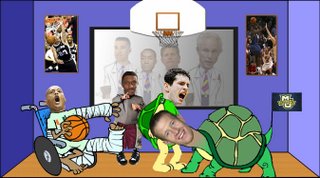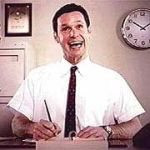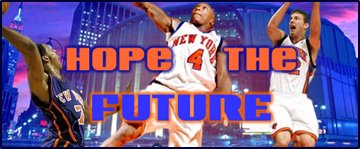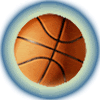Talking about draft steals gets me more excited than the Sock ‘em Boppers theme song. I just love it.
By draft steals, I mean players that are underrated by NBA front office guys, and thus get chosen later in the draft than they should. Not only is this the classic case of rooting for the underdog, but there is nothing better than seeing all of these basketball minds with the $150,000+ salaries be outsmarted by me, the kid with the blog. When a player that I have stuck with through the years gets drafted way later than he deserves, then ends up having a better career than over half the players chosen before him, I get to tell everyone about how I should have these talent evaluators' and GMs' jobs. What a phenomenon.
Every year there are players whose stock plummets because they do not show well at pre-draft camps (no matter what their accomplishments at the previous level were). Then there are the guys who are underestimated right from the beginning of the draft process: the undersized ones, the guys too unathletic to play in the NBA, the players who don't have (fill in position) skills, tweeners, etc. It seems that many professional drafters just look at a guy, dub him as one of the aforementioned taboo classifications, then do not give him another thought until he is a rotation player on a different team (with better front office personnel). Perhaps these all-too-common allocations that mean death to draft stock are direct results of GM's and others alike setting (perhaps unrealistically) high goals for their teams. Everyone wants to get the player in the draft that will blossom into an all-star, but by doing so they miss out on the sure-things... the proven players. It is almost as if drafters don't want to make their jobs too easy.
 <Click to enlarge
<Click to enlarge
Part I
Nobody wants modern day Hercules, Craig Smith. Why? Because he is not 6'10", the (supposed) size of a prototypical NBA power forward. What he is, is an inch shorter than 6'8" MVP candidate Elton Brand; a half inch shorter than multiple time Defensive Player of the Year award winner Ben Wallace (who is supposedly only 6'7 1/2", not 6'9"). Craig Smith is taller than Barkley was. So do these drafters really think that, despite his incontrovertible ability to play the game, being a couple of inches shorter than an 'average' power forward means that he doesn't deserve to be chosen above a completely unproven raw talent? The scouts like to overlook the fact that Craig Smith has shown great leadership ability, has won on all levels, and at times has carried his team on his back. And when the word undersized is brought up, what about the fact that he would immediately be one of the top 10 strongest players in the league as a rookie? He does weigh 260 lbs. Don't sleep on Craig's great foot speed either.
There is a list of 'undersized' players in the NBA to choose from that were also underestimated before they came to the league, but I will focus on Ryan Gomes. He knows just what Craig Smith is going through. Last year Gomes fell to the second round because scouts could not fathom that a 6'7" forward could succeed in the NBA. It seems that no matter how many times these scouts are proven wrong, they will remain completely incorrigible.
So Gomes was drafted by the Celtics in the 2nd round. Since second rounders aren't even guaranteed contracts, he had to try to further convince Celtics personnel that were responsible for drafting him that he can play in the league. He needed to do so in the NBA summer leagues and team practices. And, as logic would show, he was still able to outplay the very same people he was able to outperform (though not worthy of a higher draft pick than) in college.
He got his tiny, second round draft pick contract, then sat on the Celtics' bench while he watched them try to groom unproven high school talent Al Jefferson, who has not improved much since his rookie season (perhaps in part due to a midseason ankle injury). When Jefferson went down with the ankle sprain, Gomes got his chance to fill in and ***surprise surprise*** He played well. He played well just like he had on every other level he had ever played on.
The sad thing is, Gomes was even under recruited out of high school because he was seen as being undersized (and under skilled) for college...but we'll leave that alone (if you want a good laugh, listen to what Uconn's Jim Calhoun had to say about a bad loss to Gomes' Providence Friars, and about missing out on recruiting the college star... Audio.
Part II
Guillermo Diaz is built for the NBA. He is a 6'2", 180 lb. point guard. He reportedly has a
48" vertical leap with one step; 42" from a stand still (with all those italics, you
know it's impressive)
. He has great lift on his jump shot, which extends out to NBA 3 range. Scouts can even apply their favorite "He has only been playing ball for (X) years" (in Guillermo's case, 4) line. Even in his pre
ball-in-the-peach basket years, he cross trained by playing beach volleyball... at
world class level. So then why is it that he is projected to go anywhere between picks 25 and 45?
Guillermo's first season at U.Miami put him on NBA scouts' radars. His sophomore season built on his reputation, as he let it be known that he is a future NBA player. He proved that he wasn't just a freaky athlete. Yes, he could blow by anyone who was given the arduous task of trying to keep him in check, then throw down a ferocious dunk. However, more importantly, he boasted picture-perfect form on his shot, a good work ethic, was a good teammate, and drew rave reviews from coaches. After his sophomore season, there was word that if Guillermo came out that he would be a top 20 pick, but he went back to school to further polish his skills and become a lottery pick.
During that summer between his sophomore and junior seasons, Guillermo had (supposedly minor) arthroscopic surgery on one of his knees. Needless to say, he spent some time after the surgery rehabbing his knee. Unfortunately, this meant less time for him to expand on his game the way he and NBA scouts had wanted. By the time the college season came around, it looked as if Guillermo still had not yet made a
full recovery.
Guillermo did play in every game of his junior season, exemplifying his great work ethic and toughness, however he was lacking the great athleticism that inspired some to call him
The Puerto Rican Superman. Although the loss of some of his athleticism for his junior season did not help his draft stock, it may have been a blessing in disguise.
G-Mo, as his trainer calls him, could not improve upon his overall stats from his sophomore season, however there was no decline in his numbers either. With less athleticism, but equal stats, that means that he improved as a basketball player. He learned to play a slightly different - more cerebral - style. During the season, he was able to improve upon all aspects of his game, as he could no longer rely strictly on his athleticism (not that he always did in his first two seasons, but he certainly used it to his advantage). The next step in the draft process would be to prove that he still has the springs; they just needed some good, old fashioned lube.
Now, as reportedly Diaz himself proudly says, "The old Guillermo is back.'' After plenty of training and hard work, Diaz seems to have captured his old form. The previously noted 48" vertical of Guillermo's was actually measured a few weeks ago,
after the surgery. For some reason though, Guillermo is still not creeping up draft boards. Had it not been for the operation, Guillermo would undoubtedly have been a top 15 pick. The way he is playing now, it seems that the only operation he had was a jet-pack implant.
Part III
I’m thinking of a player who has been to the Final 4… netted 41 points and pulled 16 boards against a #1 ranked UConn Huskies team… is 6’10”… averaged over 17 ppg and made 46.4% of his attempts from 3 his while shooting free throws at a 97.4% clip his senior season… and is projected to be a mid-second round pick in the 2006 NBA draft.
Based on his impressive resume, it seems that the preposition of Marquette’s Steve Novak dropping to the second round of the 2006 NBA draft would be lampoonery, poking fun at professional drafters... not exactly. This high level division one basketball player is less sought after by NBA teams than roughly 40 other players, many of whom can only dream of the day they accomplish as much as Steve Novak has in the game of basketball.
Novak has less than auspicious athleticism by NBA standards. However, belying the thoughts of many, this relatively slow and skinny white guy will do just fine in the league. No, defense will not be his strong point, but he has enough in his arsenal to get by in today’s NBA. The league lacks defense just as much as it lacks good shooting, which is exactly why Steve Novak will be a good fit for any team that has front office personnel savvy enough to spot this diamond in the rough, rather than try to go for the "home run" pick.
Not quite the basketball factotum, Novak is fairly one dimensional (although only to a degree; in recent workouts he has proven that his game is somewhat protean after all). The thing about it is, this one dimension happens to be draining every shot against any team that does not have at least one man stuck to Novak as if his squad’s victory depends on it (because in all actually, it probably does) at all times.
Boding well for Novak is his head-to-toe length of 6’10”; at this height, he does not need to be wide open to get his shot off. He will make it easier on his teammates because defenders need to honor his shot. If they don't, they will see what they thought was a basketball, but in actuality is an orange leather homing projectile programmed to go through 18” orange cylinders, hit its target shortly after each launch... hearing nothing but a sound that Novak has grown quite accustomed to.









